Jaipur is the capital of Rajasthan and the state’s most populous city. It’s nicknamed the Pink City after the color of its buildings, though today most appear to be more rusty red in color. The city’s interesting architecture and mountainside forts has earned Jaipur its place on the Golden Triangle — a popular tourist circuit that also includes Delhi and Agra. This Jaipur Itinerary will help you see the best of Jaipur in just a day or two.
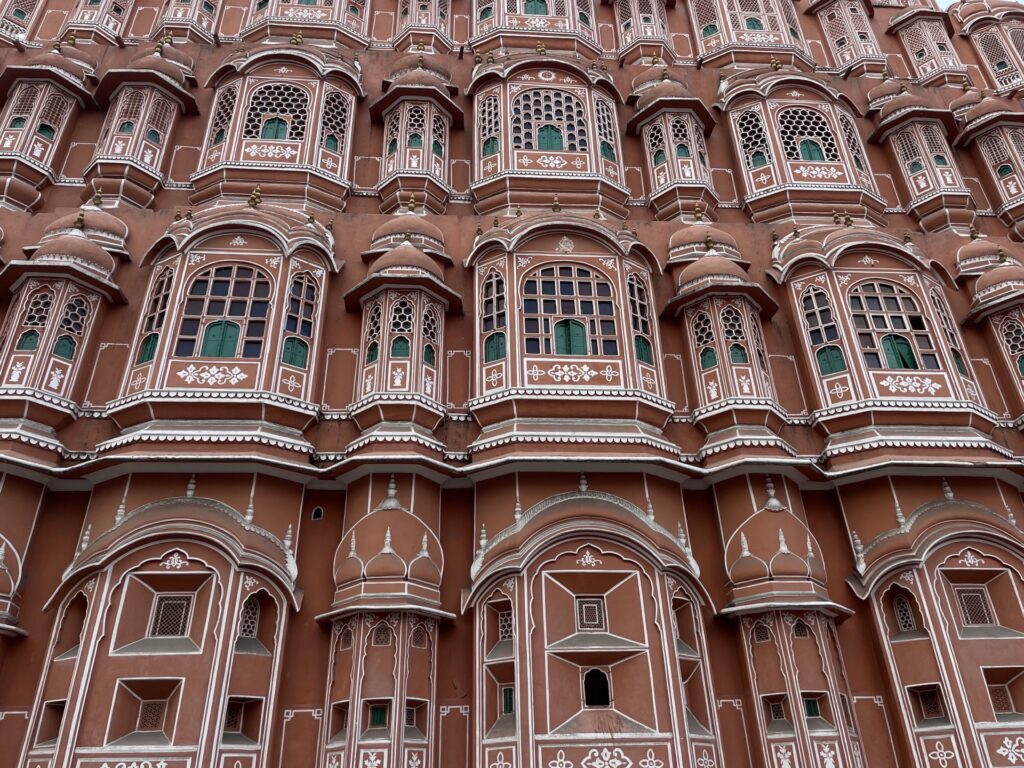
In this post
Here’s what we’re covering in this post. We’ll start with some general Jaipur travel planning information and then get into the itinerary itself.
- What is Jaipur like?
- Plan your visit to Jaipur
- Getting around Jaipur
- About this itinerary
- Day 1 — Mountain Forts & Palaces
- Day 2 — Jaipur City
- More things to do in Jaipur
What is Jaipur like?
I had prepared myself for Delhi to be the assault on my senses, but it was really Jaipur that hit me hard in that way. It was loud and fast and bright. Jaipur was exactly like how I pictured India to be before I ever stepped foot in the country.
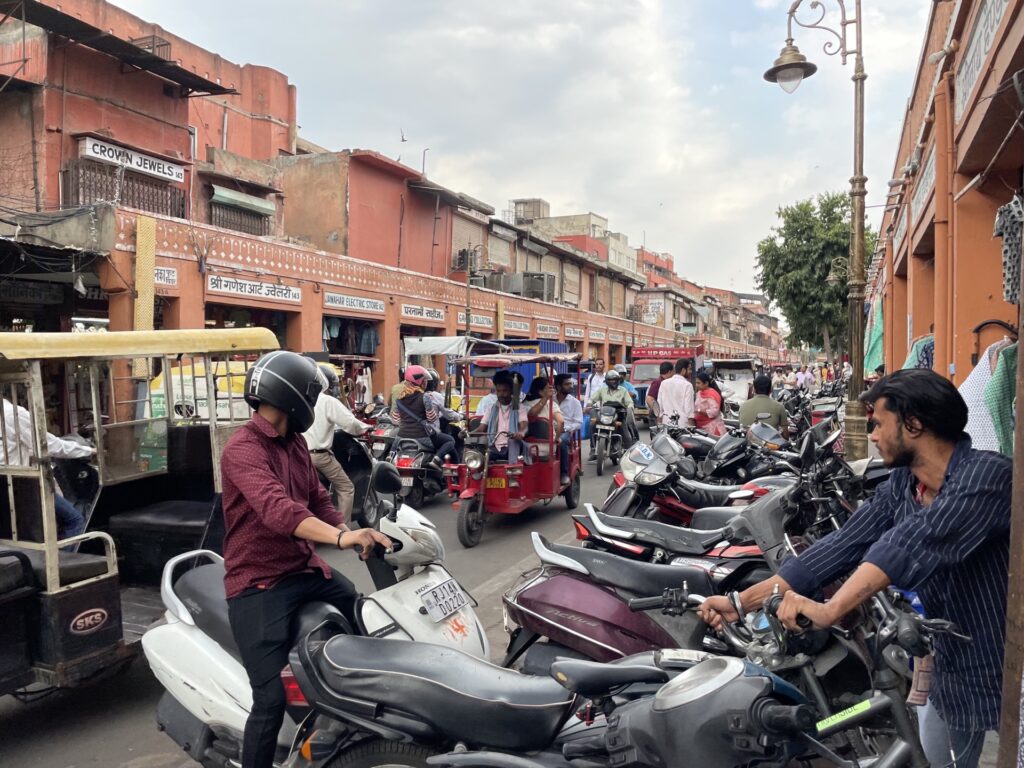
The streets were filled with a mess of colorfully decorated rickshaws, and all the sounds and smells that go with that. There were street vendors all over, offering up hot brewed chai or piles of fresh produce. Brightly colored fabrics and florals hung from every shop window and the twisty look of Hindi script made even the most basic signs look beautiful.
Jaipur actually reminded us a lot of Hanoi. It was a combination of the hectic-yet-fluid traffic, the hole-in-the-wall shops grouped by category, and the sidewalks that were as much for walking as they were for parking motorbikes.
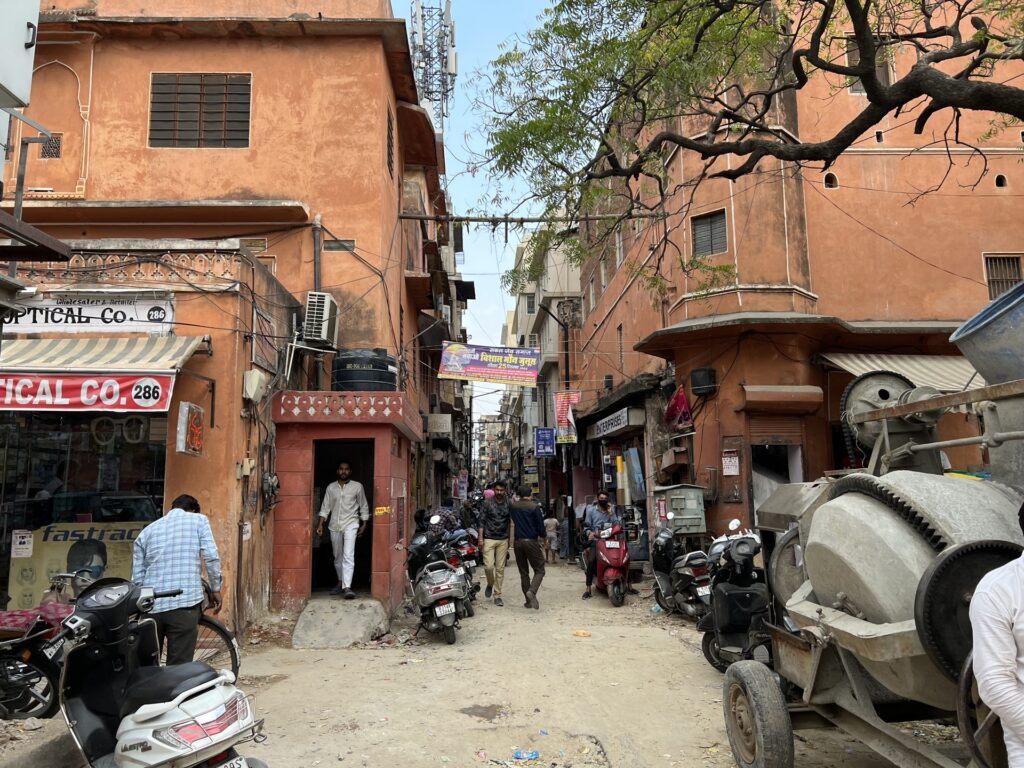
Jaipur is the name of the city, but also the district that includes other small towns nearby. Some of Jaipur’s incredible forts and palaces are located in Amer, which is a hillside town in the district of Jaipur. (FYI – In this post, I’ll use the term Jaipur to refer to the entire district.)
Jaipur City proper is separated into two parts. The Walled City of Jaipur (or the old city) is the historical center of Jaipur. It’s surrounded by city walls that were built in the 1700s to protect the city and still stand today. This area of the city was named a UNESCO World Heritage Site in 2019 and is where major sites like the City Palace and Hawa Mahal are located. Everything outside of the city is considered to be new Jaipur (or just Jaipur).
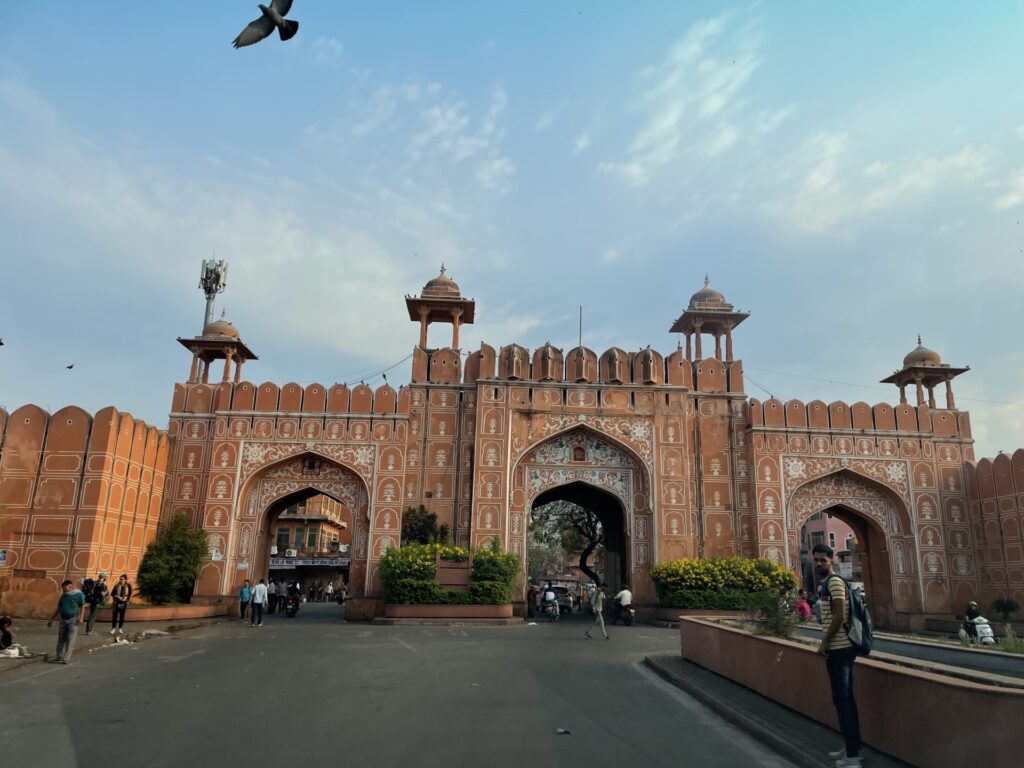
Jaipur is the 10th largest city India with over 4 million people. It’s a large city, but not a metropolitan one. Sure, there’s a McDonald’s, but there aren’t many chain restaurants or stores and the people of Jaipur tend to be quite conservative. Even without skyscrapers and high rise apartments, it has a population density somewhere between that of Chicago and Paris.
Overall, Jaipur is a bustling city that still captures the charm of its historical roots.
Plan your visit to Jaipur
In this section, we’ll get into some of the practical information for planning a trip to Jaipur. Some of this information, like the visa requirements and weather, is very similar to the corresponding sections in our Delhi Itinerary.
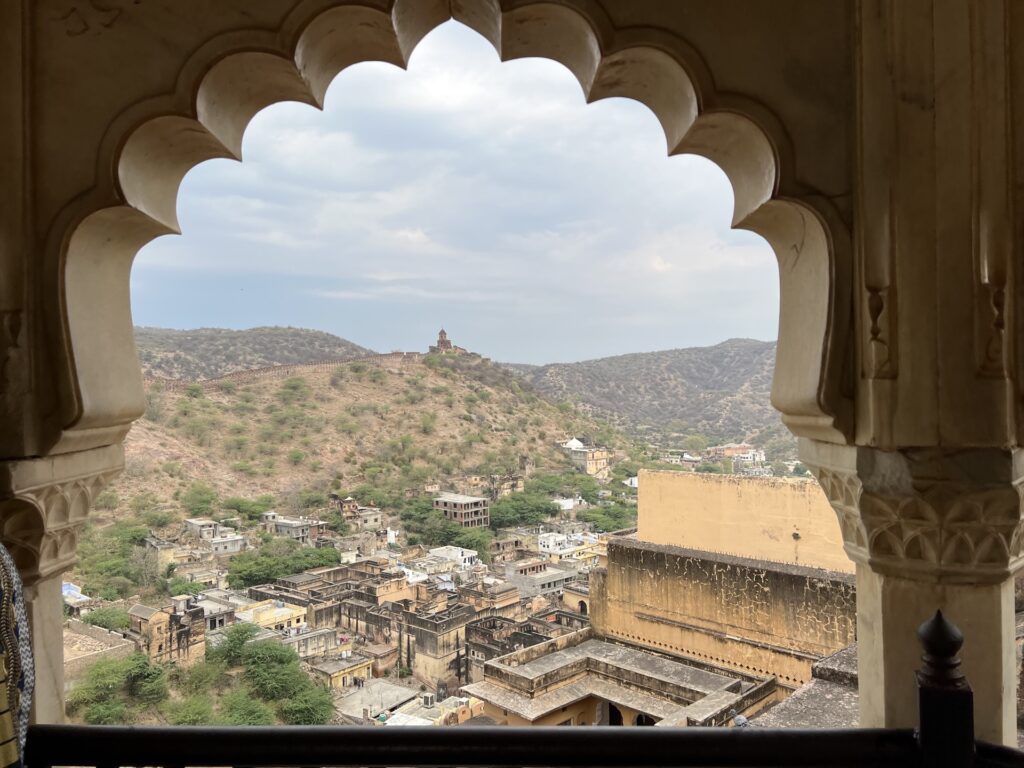
India Visa requirements
To get to Jaipur, you’ll first need to get into India, which requires a Tourist e-Visa. The Tourist e-Visa is required for visitors from almost every country and has three available durations (30 days, 1 year, 5 years).
You can apply for an Indian Tourist e-Visa online. You will need a valid passport, passport photo, and credit card to pay the application fee. The application fee varies based on your nationality, but most will pay $10 or $25 USD for a 30-day visa.
In most cases, this is a quick and easy process, but don’t put it off to the last minute. It can take longer if complications come up.
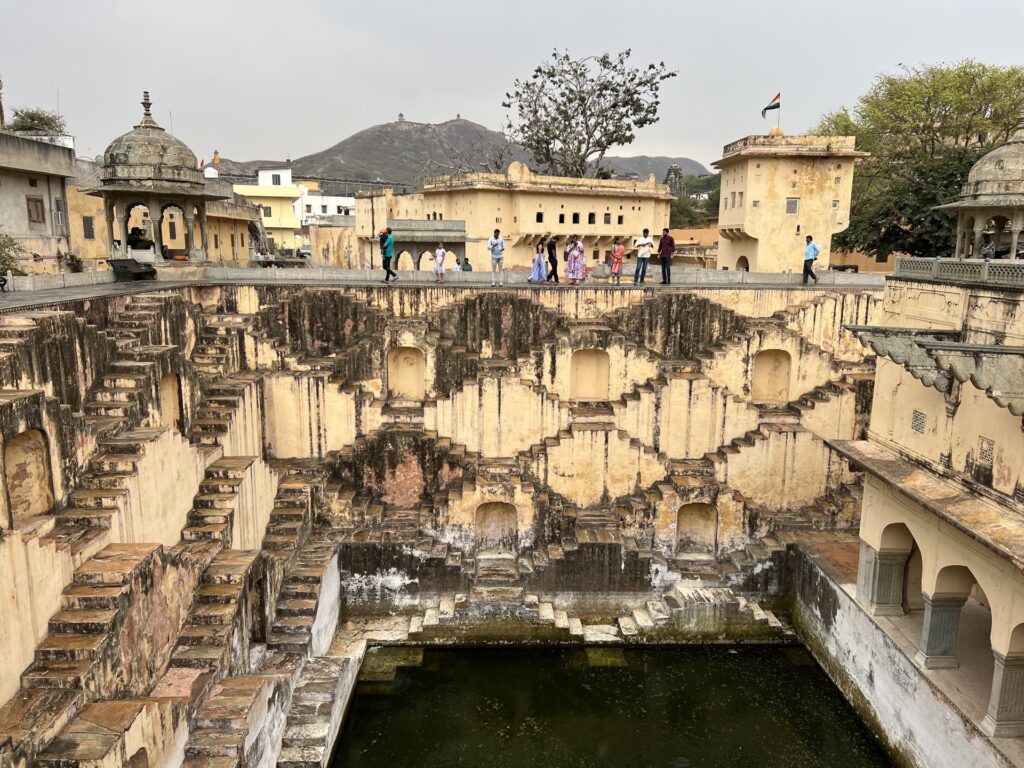
Recommended vaccines
India does not have any vaccine mandates (unless you’re traveling from a Yellow Fever country), but you might want to get a few before traveling there. In the United States, the CDC recommends the following vaccines for travelers going to India. Other countries may have different guidelines.
(Disclaimer: We are not doctors and this is not medical advice. Consult your physician or a travel clinic for professional recommendations.)
- COVID-19
- Hepatitis A
- Hepatits B
- Measles
- Yellow Fever
- Rabies
- Typhoid
- Cholera (not prominent in Jaipur)
- Malaria (not prominent in Jaipur)
- Japanese Encephalitis (not prominent in Jaipur)
We were already up to date with most of these vaccines including: Covid, Hep A, Hep B and measles. We also already received Yellow Fever vaccines before traveling to Colombia a few years ago. (I wouldn’t have gotten it just for this trip.) Based on our travel plans (Delhi, Jaipur, Udaipur, Agra), we weren’t at high risk for cholera, malaria or Japanese Encephalitis. That left us with Rabies and Typhoid to consider.
If it was just us adults, we probably would have skipped both. But we are responsible parents traveling with our 2-year-old, so we had a travel consultation with our pediatrician. She actually didn’t strongly recommend any additional vaccines other than Hep A, which we were due for anyway.
We decided to skip the rabies vaccine. There are some stray dogs in Jaipur (not nearly as many as Delhi), but we assumed we would be able to stay pretty clear of them. Typhoid spreads through contaminated water, though, and that seemed like a risk that would be harder to avoid completely. We decided to get the Typhoid vaccine for all of us.
The Typhoid vaccine is expensive. It costs around $150 and most insurance doesn’t cover it. (Our insurance covered children but not adults.) It’s also really hard to find. In many cases you have to go to a travel clinic to get it, which can sometimes cost another few hundred dollars. Some CVS locations carry it, especially in major cities, so be sure to check there.

How to get to Jaipur
If you’re going to Jaipur from either Delhi or Agra as part of the Gold Triangle, you will have the choice of train or car. Jaipur does have an airport, but once you consider the amount of time it takes to get through security at Indian airports (particularly Delhi) and the amount of time it takes to get from the airport into the actual city, it’s not usually worth it.
In our experience, the trains in India were efficient and mostly ran on time. If you’re booking a train, we suggest using the third-party service 12Go Asia. We used them to get around all of Southeast Asia, and again relied on them to get us around India. They make booking easy and their customer service is incredible.
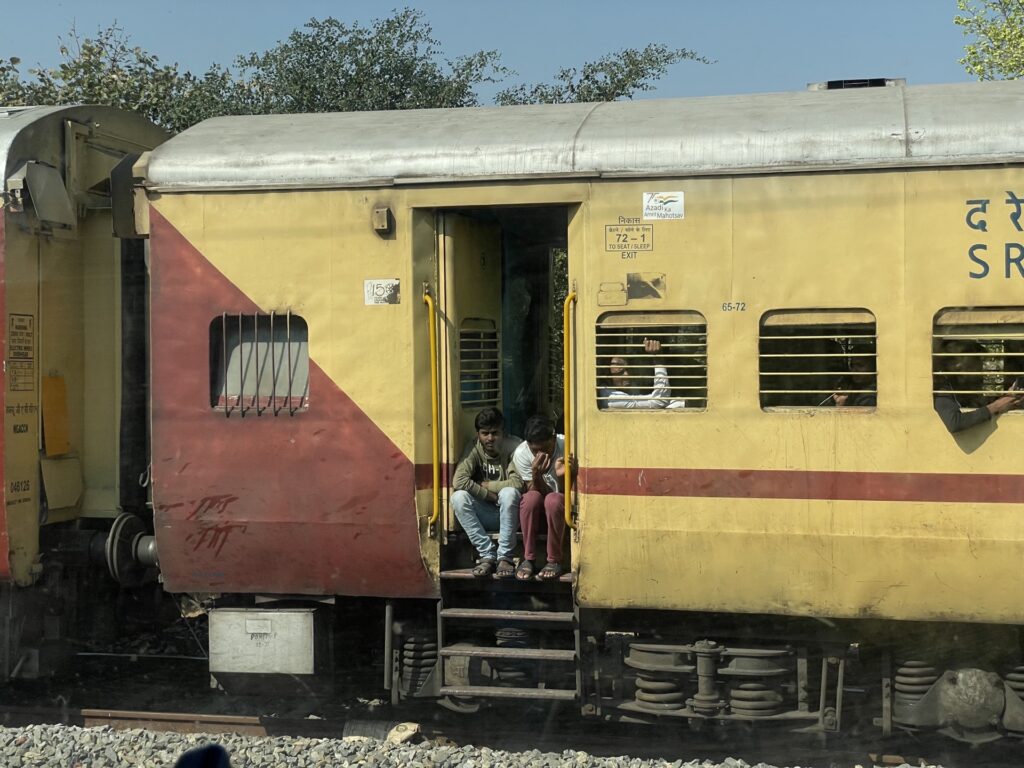
Indian trains are famously crowded. In our experience, this was accurate, but it was limited to certain travel classes. Be sure to book one of the following fare classes to avoid overcrowded cabins and ensure you have a reserved seat and AC. We recommend booking the highest class available within these options.
- CC, AC Chair Class (open cabin)
- 3A, AC 3-tier Sleeper (open cabin)
- 2A, AC 2-tier Sleeper (open cabin)
- 1A, First Class Sleeper (closed berth)
There are a few different trains that go to Jaipur from both Delhi and Agra. The fastest train from Delhi to Jaipur takes about 4.5 hours and costs $12 – $22 USD. The fastest train from Agra to Jaipur takes about 4 hours and 15 minutes and costs about $10 USD.
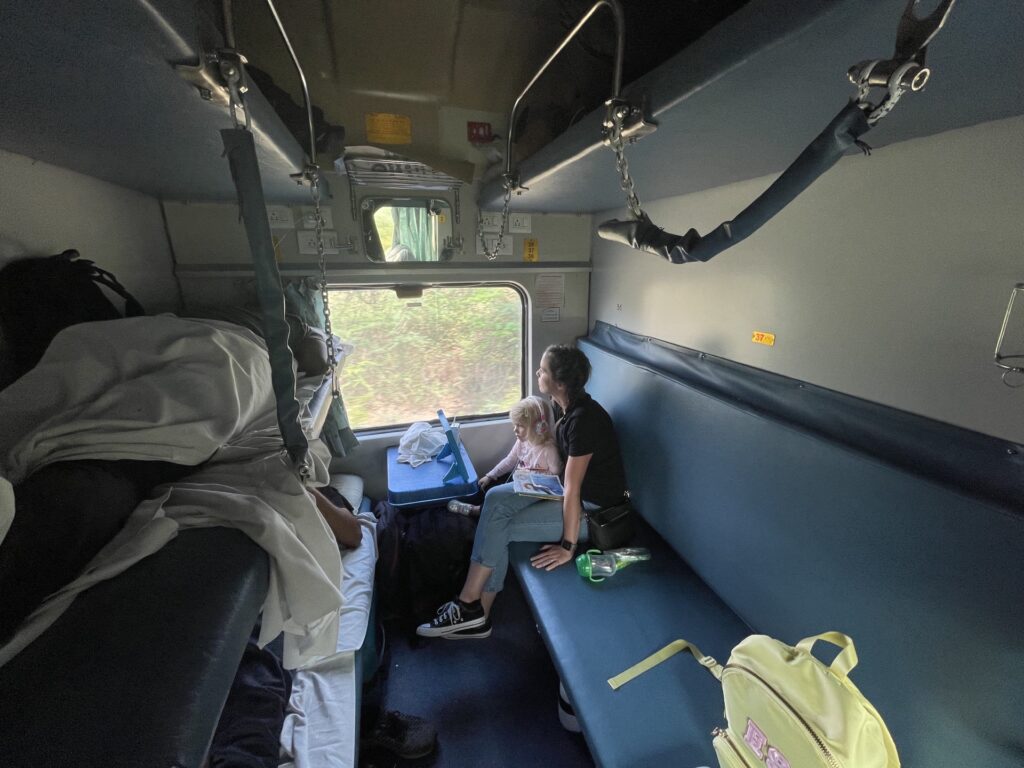
Alternatively, you can hire a driver to take you to Jaipur. The drive is roughly the same amount of time as the train, but the obvious advantage is that you have control over the timing. A car will also get you point-to-point, and you won’t have to worry about any additional transit time or expenses to go between the trains stations and your hotels.
We hired a driver from Delhi to Jaipur through Bagga India Tour and it cost $141 USD. (This particular company is no longer in business.) Drivers from Agra to Jaipur typically start around 3,000 rupees ($35 USD). You can save some money if you hire a driver for the entire Golden Triangle versus just one let, but we were taking a detour to Udaipur so that wasn’t going to work for us.
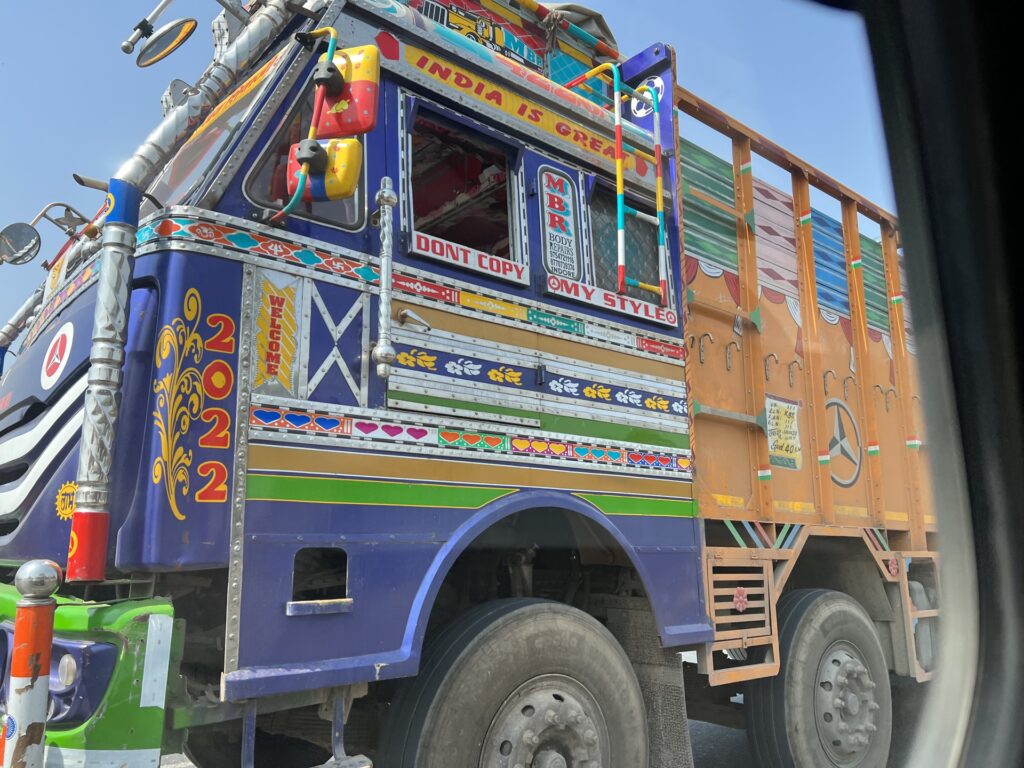
Where to stay in Jaipur
There are two main locations for hotels in Jaipur. You can either stay in Jaipur City proper in the area around the old city or up by Amer Fort in the town of Amer.
Jaipur City Palace is the center of the old city. There are a variety of hotel options along the main street that runs from City Palace up to Jal Mahal (the water palace) and then more options south/southwest of City Palace. There’s a good chance you’re going to need a car or tuk tuk to get around to most places, so pick your hotel more so by quality than by the specific location within Jaipur City.
We personally stayed at Jai Mahal Palace, which is pretty far from the old city but near the train station. It’s a really nice hotel built inside an old palace. We didn’t love the service here (or all the pigeon poo by the pool), but all things considered it was a very nice hotel.

Alternatively, you can stay in Amer. This town at the base of Amer Fort seemed very walkable and had many hotels, restaurants and shops. It’s a hike from the rest of Jaipur, but it looked like it had a fun backpacker energy to it.
How long to stay in Jaipur
You probably don’t need a ton of time in Jaipur. It’s a big city that has some interesting things to see and do, but you can definitely fit it into a short stay. Honestly, I’d say that one full day is enough to see most of Jaipur at a fast pace and two days is good if you want to do it slowly.
We personally spent two days and three nights in Jaipur. However, after one full day of sightseeing, we spent the entire second day relaxing at our hotel. (For what it’s worth, we were here with a toddler and had just spent three full days in Delhi and kind of just needed a break.)
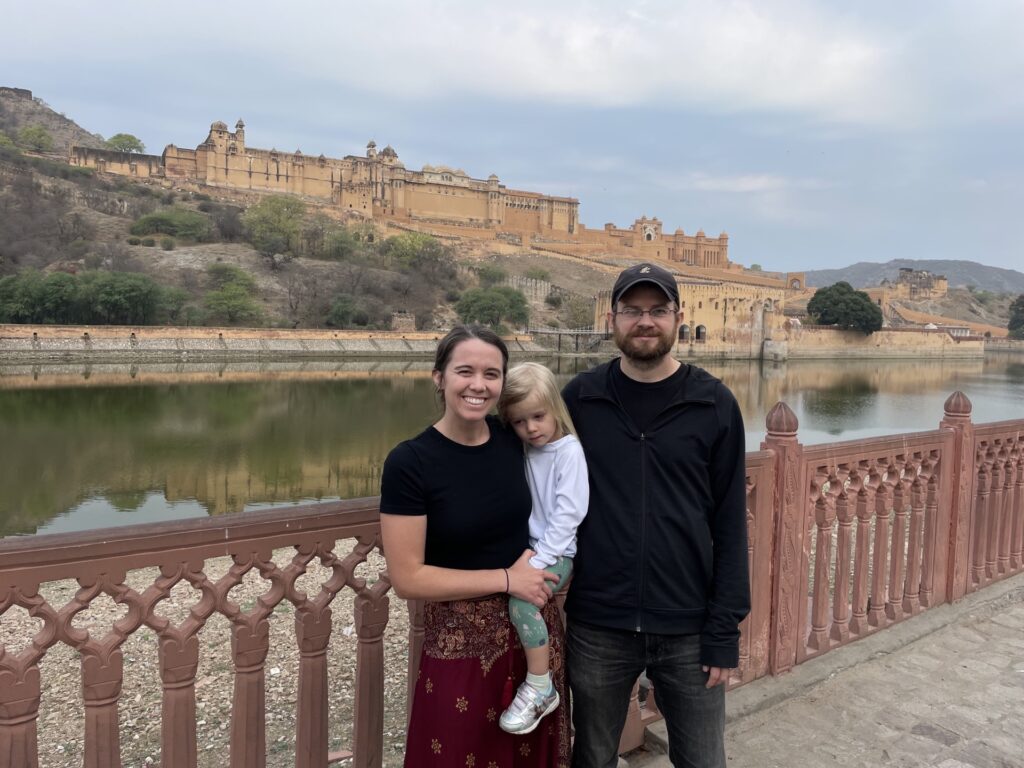
When to go to Jaipur
Jaipur is located just southwest of Delhi. The weather in the two cities is very similar, but Jaipur tends to be a bit warmer. In this area of India, the weather changes drastically by season. More than many other destinations, its really important to plan a trip to Jaipur at the right time of year.
Here’s a look at Jaipur weather by season. All temperatures are in °F.
- Summer in Jaipur (April – June): Summer is extremely hot with temperatures regularly hitting 100°F or higher.
- Monsoon Season in Jaipur (July – September): The monsoon season starts in late June and brings with it heavy rains and humidity. Highs tend to be in the 90s with lows in the 80s.
- Fall and winter in Jaipur (October – January): The rainy season gives way to a milder fall and winter. High temps steadily drop down to the 70s and lows into the 50s. Even in the winter months, temps rarely fall below the upper 40s.
- Spring in Jaipur (February – March): Temperatures shoot up quickly in the spring and can vary greatly by the day. Highs will hit the 80s and 90s and lows will move up to the 60s and 70s.
The best time to visit Jaipur is in the late winter or early spring (January through March). You definitely want to avoid the summer’s crippling heat and monsoon season.
Other than weather, you may also want to plan around holidays and festivals. Jaipur hosts a popular Kite Festival and Literature Festival every January. It’s also a popular city for celebrating Diwali, Holi and other Hindu holidays.

What to wear in Jaipur
As we drove from Delhi to Jaipur, I saw a sharp change in what people were wearing — particularly women. In Delhi, there was a lot more western and modern dress mixed in with more traditional saris and kurtas (a long tonic worn over pants). By the time we arrived in Jaipur, I found that nearly all of the women were dressed in saris. Specifically, the women in Jaipur wore their sari with the pallu (or loose end of the sari) covering their head.
For that reason, I’d suggest erring on the conservative side with your clothing choices in Jaipur. You certainly don’t need to wear a sari yourself, but I would try to keep your shoulders and knees covered. A maxi dress or a long skirt with a t-shirt is a great option for women in Jaipur. You’ll keep cool and won’t stand out too much. I would avoid shorts, short skirts, and tank tops.
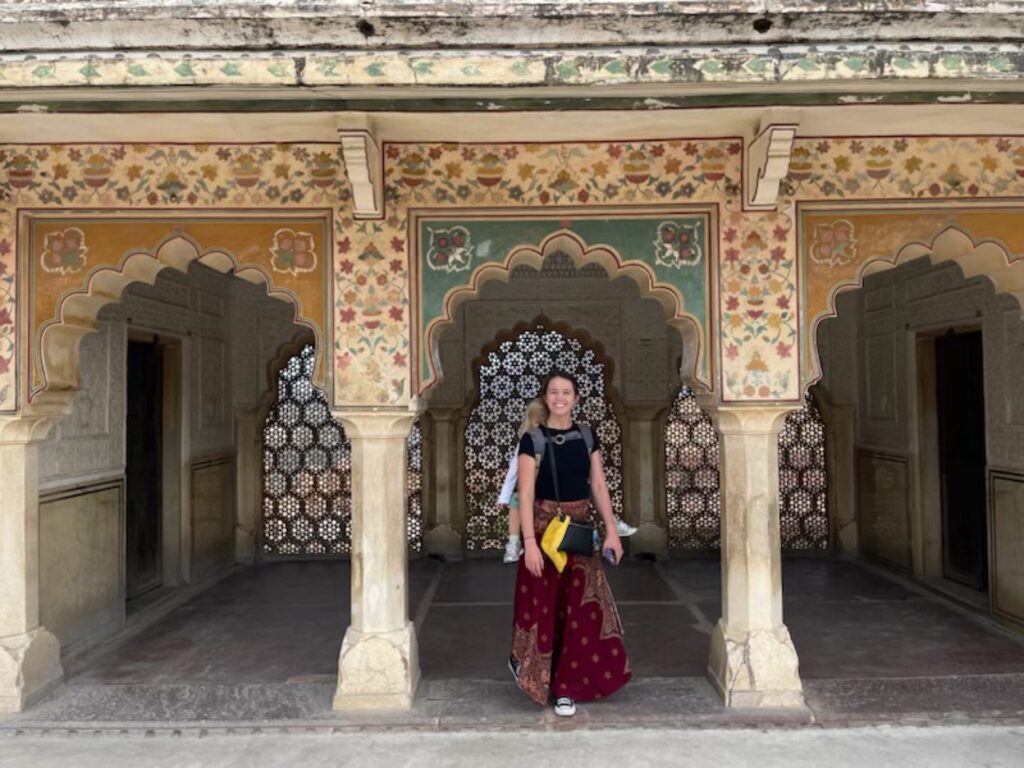
Most men were wearing jeans and t shirts or polos, so I would recommend men wear something along those lines.
Getting around Jaipur
The tourist attractions in Jaipur are pretty spread out. There is a cluster of things in the old city, walkable from the City Palace, but then everything else is a bit of a hike.
Jaipur does have a Metro, but there are only two lines. If your hotel happens to be along the Metro, it is a convenient way to get to the old city. However, it doesn’t to connect to much else, including the Amer Fort.
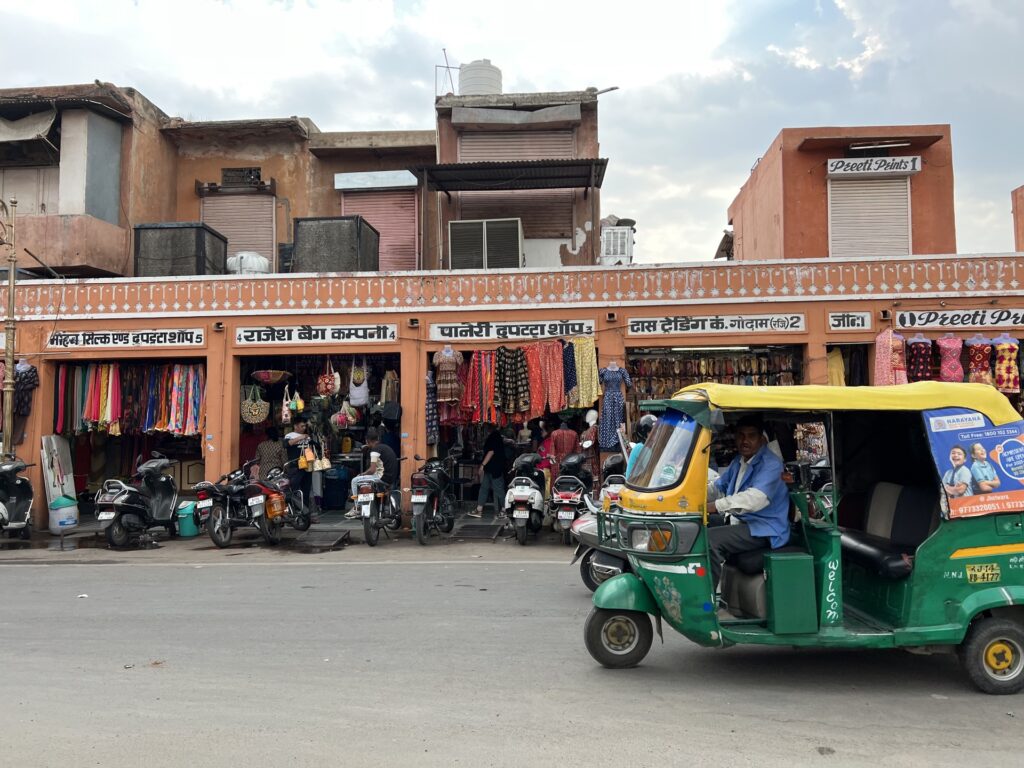
To get around Jaipur, you’ll want some wheels. The cheapest way to get around Jaipur is by tuk tuk (or auto rickshaw). They can be hailed all over the city and can always be found near tourist attractions. You can hire a tuk tuk for each individual trip or you can hire a driver for the entire day. The later is often cheaper and will cost somewhere around Rs. 500-700 ($6-9 USD) for the day.
Tuk tuks are a great way to ride like a local. However, if you’re traveling with kids who need a carseat or just aren’t keen on riding without seatbelts or doors, you may want to hire a car with a driver instead. We booked a car through our hotel and it cost about Rs 10,000 ($120 USD).
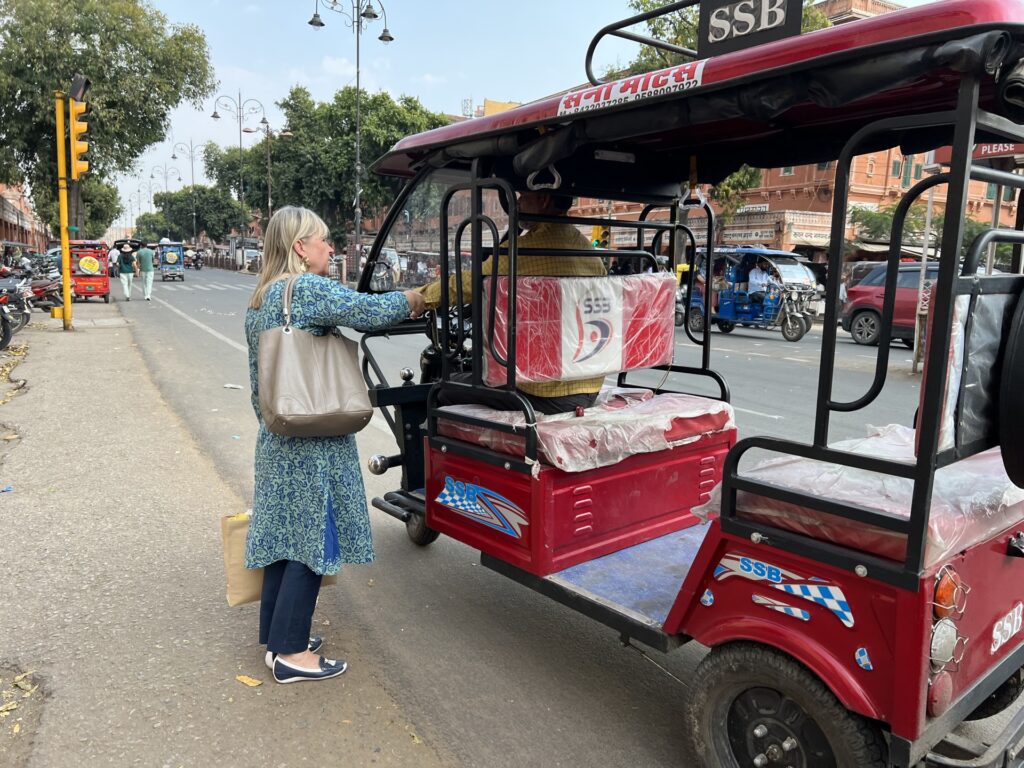
Jaipur has another unique mode of transportation: elephants. This is most commonly seen at Amer Fort, where people ride elephants up the steep hill to the fort’s entrance, but you’ll see them around the town, too. We do not recommend riding elephants.
When we visited an elephant sanctuary in Chiang Mai, we learned that elephant’s backs and spines are not designed to be weight bearing. Riding elephants can result in permanent injury. The elephants here are also not treated that well. We do not want to perpetuate the abuse, so we’d encourage you to skip the elephant rides.
About this Jaipur itinerary
In this itinerary, we’ll explore explore Jaipur over one or two days. If you only have one day, follow the day 1 schedule. If you have more time, tap into the activities on day 2.
You will need to hire either a car or a tuk tuk to get you around to the different attractions. We personally hired a car through our hotel, because our little one needed a car seat. Hiring a tuk tuk for the day would have been cheaper.
Many of the sites listed here have signs posted in English and Hindi, but if you want to learn more about the history you might want to hire a guide. In Rajasthan, guides are regulated by the government. They have to have credentials and charge a set rate. For each site below, we’ll note if guides are available and how much they cost.
Lastly, this itinerary is targeted toward first-time visitors. It’s packed with the city’s most popular attractions and doesn’t explore many of the hidden gems or secondary attractions that would likely fill subsequent visits.
All set? Let’s explore Jaipur!
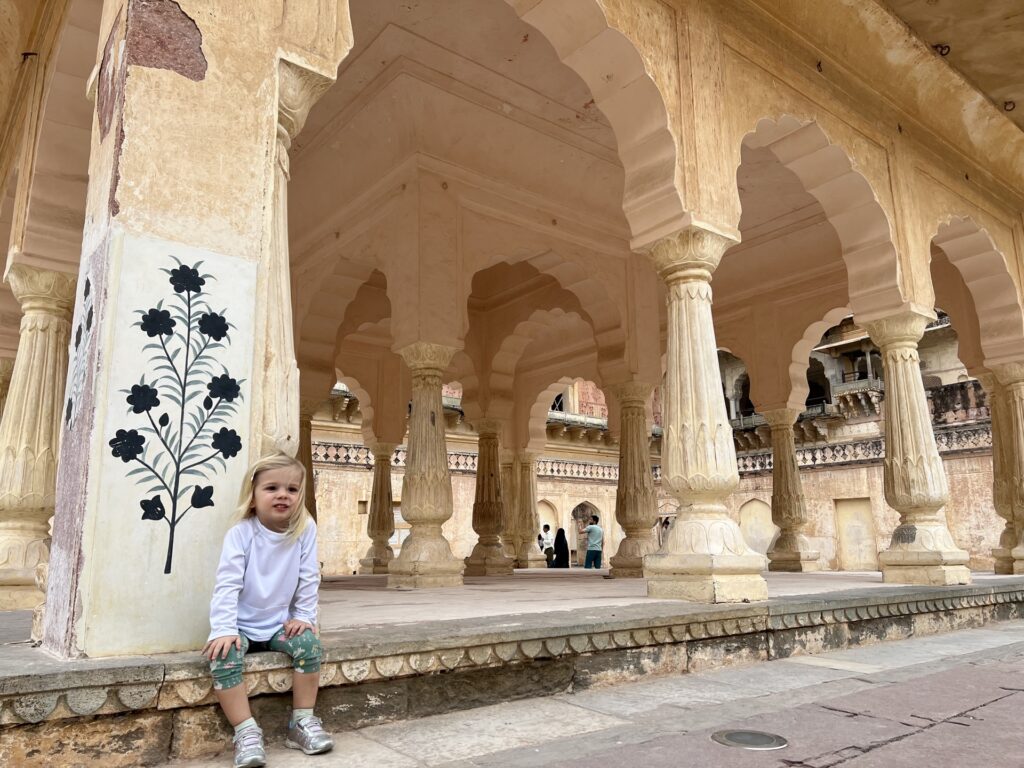
Day 1 — Mountain Forts & Palaces
You can pack a lot into one full day in Jaipur, and we’re going to do just that. We’ll start our day up in the Aravalli Hills, exploring hilltop forts and palaces, taking in some epic views and enjoying some of the most delicious local foods. Then we’ll go back into the old city to see a couple more iconic Jaipur sites.
Start your day early — we recommend around 8 AM. This schedule should keep you busy until about 5 PM.
Panna Meena ka Kund (Step-well)
- Location: Here — The entrance is on the southwest corner along Sagar Road. There is space on the road nearby for vehicles to park and/or wait.
- How to get there: Unless you’re staying in Amer (then you can walk), you will need a car or tuk tuk to take you here.
- Hours: 7 AM to 6 PM, everyday
- Price: Free
- Tickets: No tickets required
- Guide info: We did not notice any guides for hire here.
- How long does it take: 15 minutes
On the way to Amer Fort, make a quick stop here first. You can also do it after, but the way the one-way traffic works in the hills around the fort, it’s out of the way to come back to it later.
Panna Meena ka Kund is a large step-well with a beautiful cross pattern of stairs along all four sides. This type of well, which has steps leading down to a water source, is common in India because it allowed people to reach the water at a variety of depths based on the season. Most step-wells, including Panna Meena ka Kund, are no longer in use today.
You cannot go down the steps at Panna Meena ka Kund, but you can walk the parameter. The step-well itself is quite beautiful and worthy of a quick visit. It’s also right across the street from Bihari Ji Temple, which you may also what to take a quick look at.
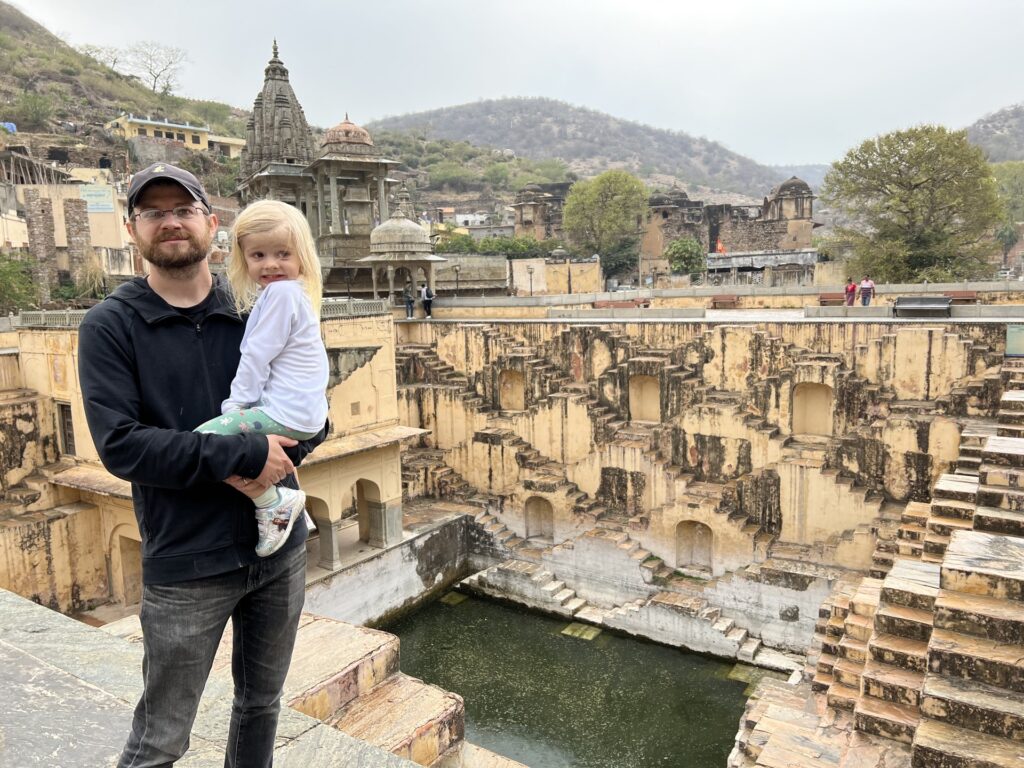
Amer Fort
- Location: Here — The entrance to the fort is near Chand Pol gate on the north end of the complex. If you’re arriving by car, the parking lot and drop-off area is just north of here.
- How to get there: Take a car or tuk tuk to the entrance. Jeeps are also available for hire from the base for Rs. 500 roundtrip. The entrance is at the top of the hill and only accessible via a windy road. Even if it looks walkable on a map, it is not.
- Hours: 8 AM – 5:30 PM, everyday (NOTE: Some websites say the fort opens at 9 AM. I can confirm that the fort was well open by our arrival at 8:30 AM.)
- Price: Rs. 500
- Tickets: You can buy tickets online in advance here or there is a ticket window near the entrance
- Guide info: Guides are available for hire all around the Amber fort, including at the base, along the drive up the hill, and near the entrance. Guides cost Rs. 400 for 1 person, Rs. 600 for 5 – 15 or Rs. 1000 for 15-35.
- How long does it take: 2 hours
This specific site goes by a handful of different names. Amer Fort, Amer Palace, Amber Fort and Amber Palace are all different names for the same place. It is both a palace and a fort. The palace was built in the late 1500s as a residence for the royals (Rajput Maharajas and their families). Located high on a hill and fortified by walls and other protective elements, it’s also considered a fort.
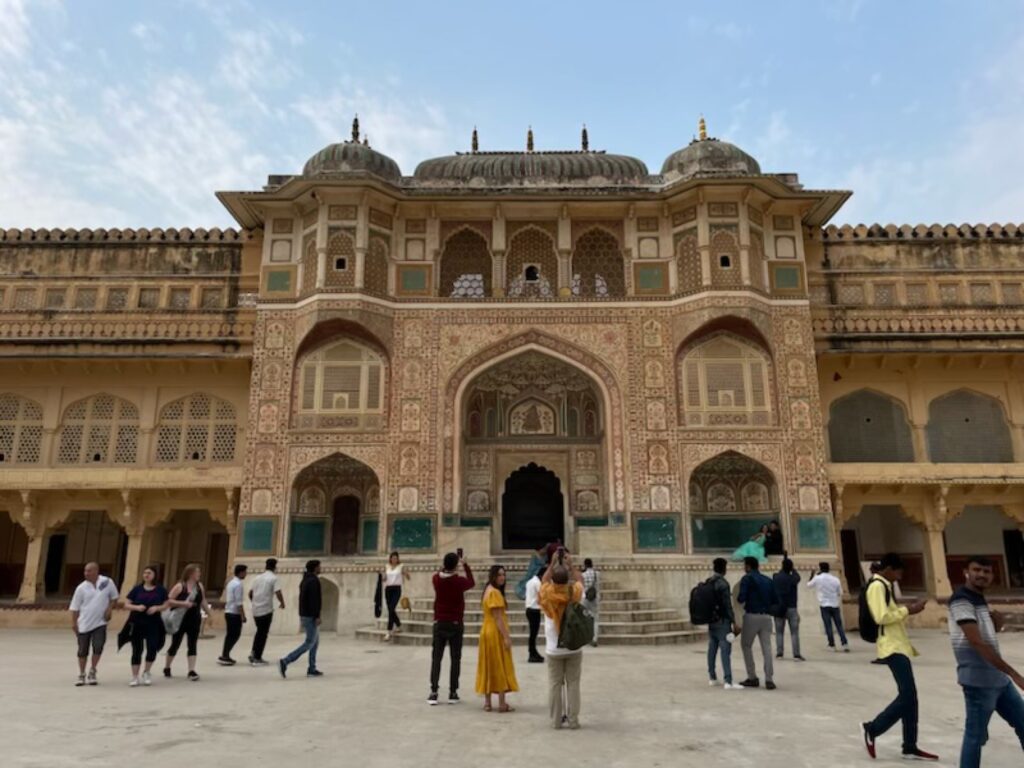
The entrance opens up to a large square, where military parades used to be held. Today, this is where you will find the ticket booth, snack stand and lots of people selling souvenirs. To the right is a large stairway leading up to the palace itself.
Once you enter, you’re free to explore most of the large palace. It’s primarily broken up into four main courtyards, but there are lots of small hallways and hidden stairways that could keep you busy (and a little lost) for a while.
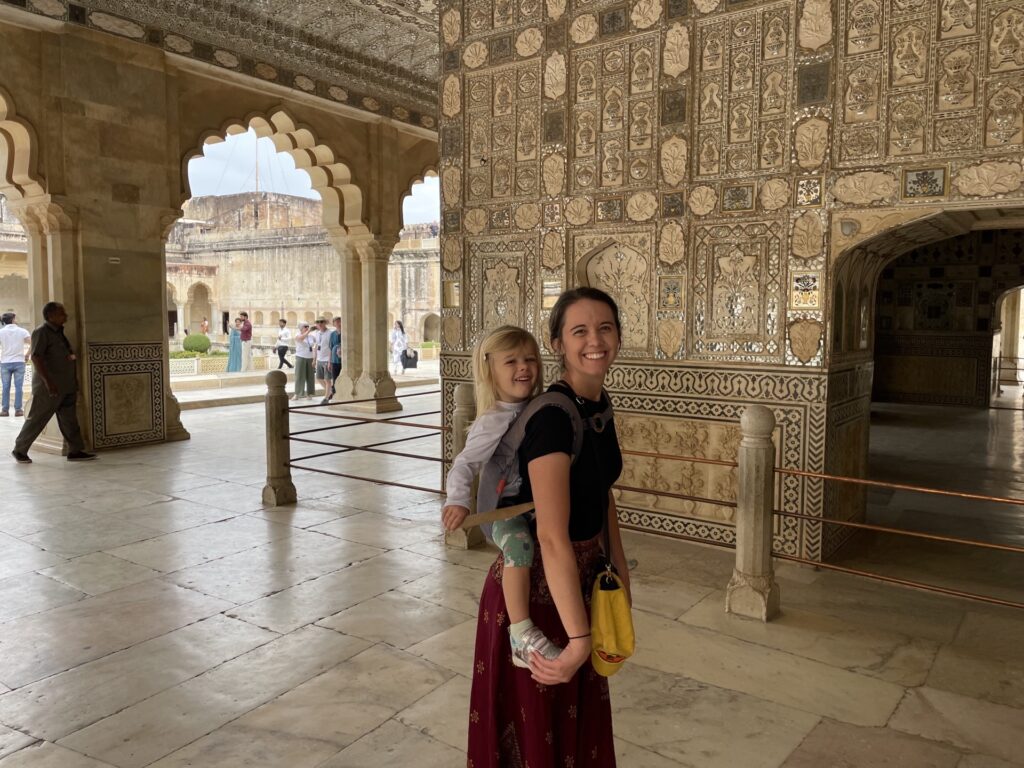
The entire complex is beautiful. There are intricately carved pillars, beautifully painted gates, and stunning arc-framed views over Amer and Jaipur City. Some of the most beautiful and popular spots are Ganesh Pol (the first main gate you see when you enter), Sheesh Mahal (also called the Hall of Mirrors because of it’s mosaic of mirrors) and Jas Mandir (located above the courtyard near Hall of Mirrors).
Amer Fort is a popular photo spot. There were lots of photographers shooting engagement photos and influencers getting their shot. Pair that with every other tourist trying to get a picture and it is a lot. For the best photos and lowest crowds, plan to arrive by 8 AM. (We got there at 8:40 and it felt too late.)
If you want Hall of Mirrors photos, go there first, because it’s the most popular. I honestly liked the first gate the best, though.

Jaigarh Fort
- Location: Here — not far from Amer Fort
- How to get there: One option is to walk. There is an open-air passageway that connects Amer Fort to Jaigarh Fort that is just about 1 mile long. Alternatively, you can take a car/tuk tuk between the two, but driving the five miles along winding roads through the hills will take you about 20 minutes.
- Hours: 9 AM – 6:30 PM, everyday
- Price: Rs. 100
- Tickets: There is a ticket booth located near the entrance. Tickets are not sold online.
- Guide info: There are no guides advertised, however there are people who will show you around inside (whether you ask for it or not) that you’ll need to tip.
- How long does it take: 1 hour
While the royals lived in Amer Fort, nearby Jaigarh Fort was built as the primary military and defense fort. The structure itself is utilitarian in nature and not nearly has beautiful as Amer Fort. For that reason, Jaigarh Fort tends to be much less popular and is often skipped or overlooked. This is exactly why it should definitely be on your itinerary. You can enjoy some of the best views in town and have it largely all to yourself.
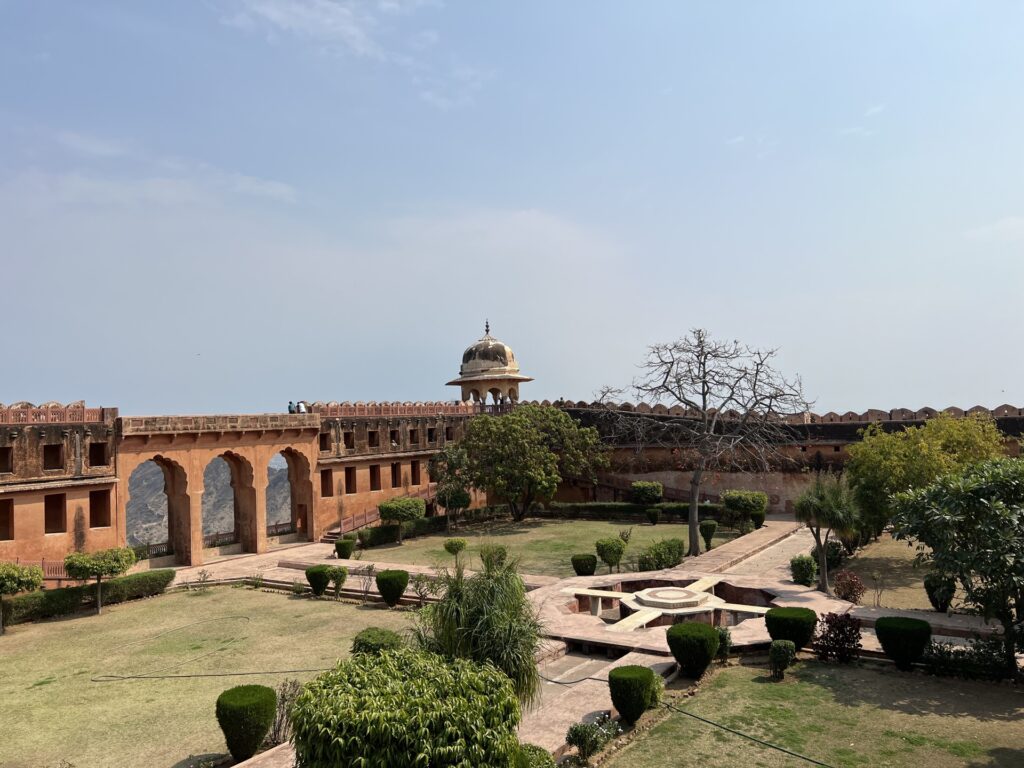
The fort is wide and pretty spread out. After the entrance, the the route splits in two. You can turn right and follow signs to the world’s largest cannon on wheels. The cannon is fine, but the views overlooking Jaipur City from here are are more impressive. Or you can carry on straight to explore the bulk of the fort.
Most of the fort has small museum style exhibits with model scenes, old weaponry, artwork and more. You can explore the passageways, courtyards and rooms all around the fort.
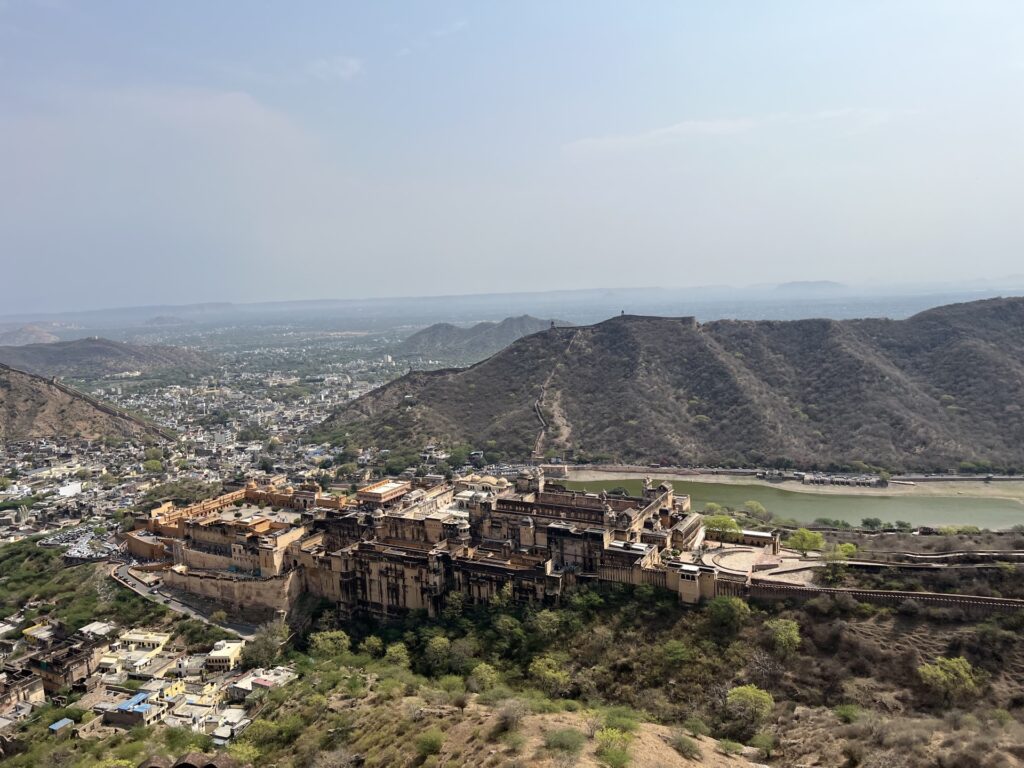
This is all fine, but the best part of this fort is the views overlooking Amer Fort and the surrounding Aravalli Hills. To get to the viewpoint, follow signs toward Laxmi Vilas and then to Sagar Chatri. This is where you’re likely to be picked up by guide who will show you around and explain everything to you. We ended up tipping Rs. 500 ($6 USD) which was very generous.
Sagar Chatri is the garden with the most stunning views. (Watch out for monkeys, though! They will definitely take your stuff.)
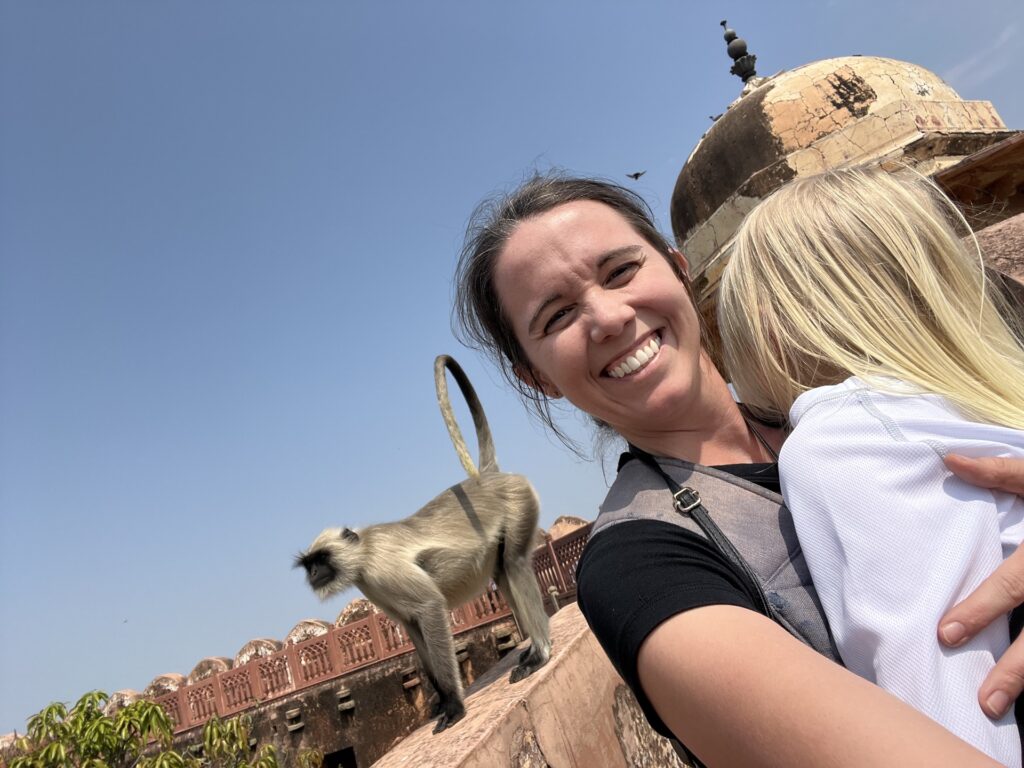
If you’re already hungry and don’t want to drive back into Amer, grab lunch at the cafe here. Otherwise…
Thali Lunch at Zeeman Restaurant
- Location: Here — it’s back toward Amer, so it’s a little out of the way, but still worth it.
- How to get there: Hire a car or tuk tuk
- Hours: 9 AM – 10 PM, everyday
- Price: Rs. 250 – 400 per person (USD $3 – 5)
- How long does it take: 1 hour
Thali is a traditional way of serving food in India. The word translates to “large plate,” on top of which are many small bowls containing several different dishes. It’s a really great way to try a variety of foods just like the locals do.
Zeeman Restaurant is really popular and highly rated. They have a large menu with a variety of (vegetarian) items, but Thali is their specialty. While there are several different variations, I’d recommend getting the Rajasthani Special Thali. This one features a traditional variety of local foods eaten in the region.
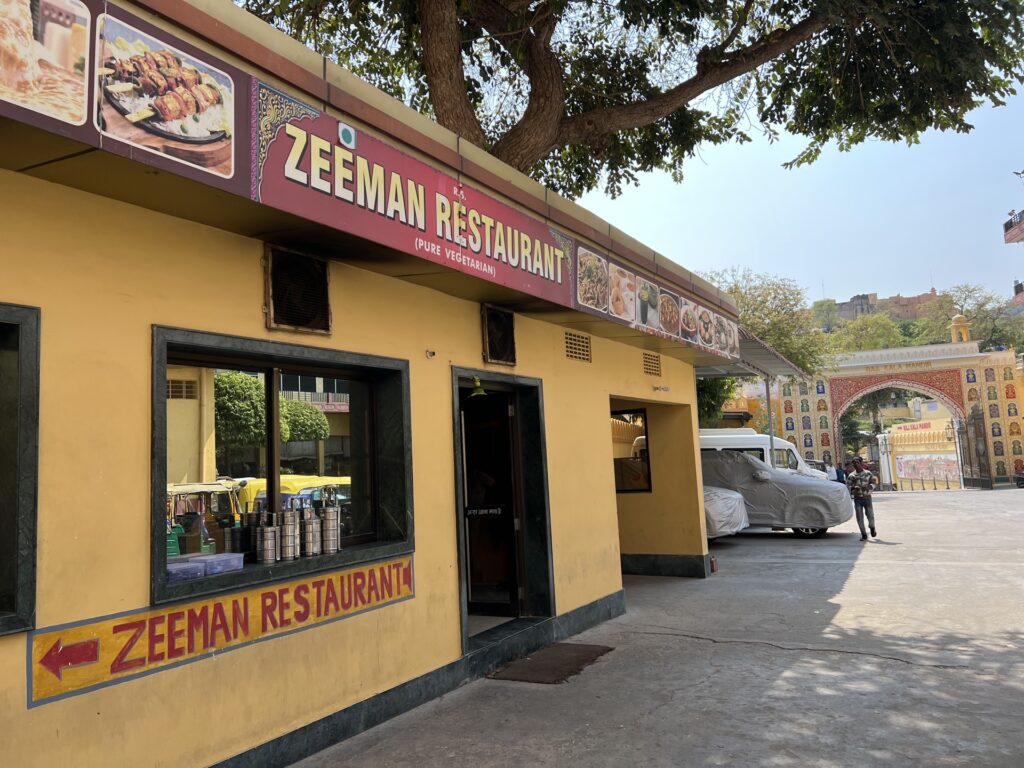
Ask your server to explain how to eat the foods together. For example, you’re supposed to eat the round bread with the dal and the powdered stuff is dessert. You might not like everything, but it’s fun to try it all.
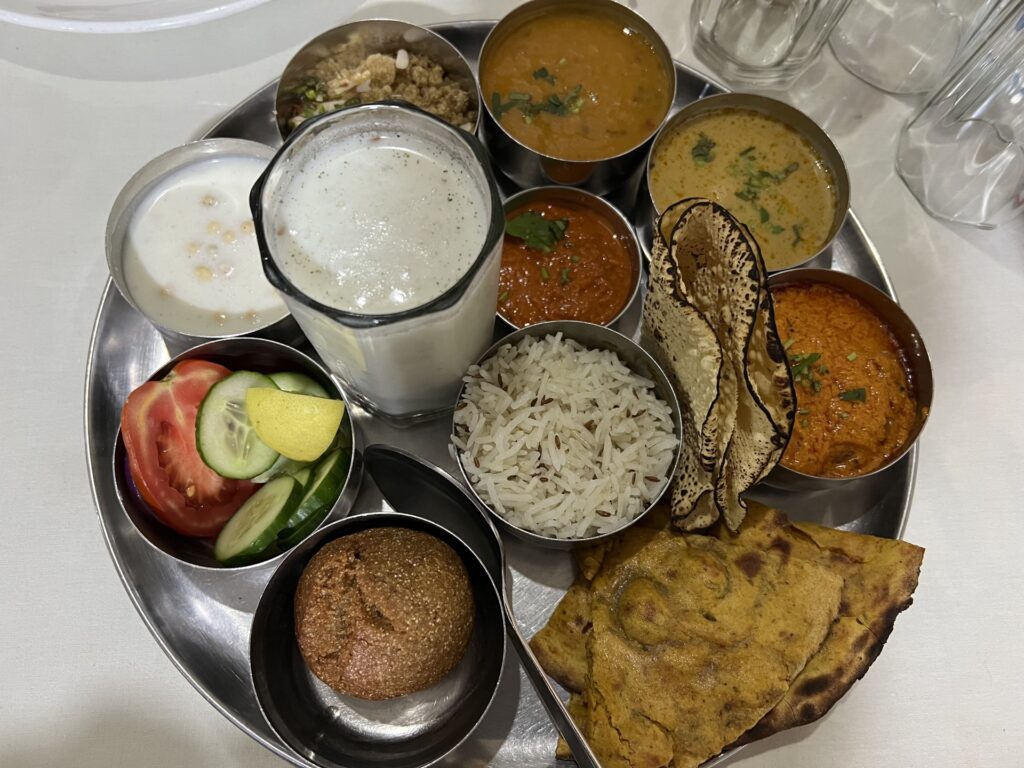
Jal Mahal
- Location: Here — in the middle of Man Sagar Lake
- How to get there: Take a car or tuk tuk to the viewing area along Amer Road. You will pass it on the way back from Amer to Jaipur City.
- Hours: Visible at any time
- Price: NA
- Tickets: NA
- Guide info: NA
- How long does it take: 15 minutes
Jal Mahal is called the water palace, but it was never intended to be a palace or to be surrounded by water. It was originally built as a five-story hunting lodge. It was flooded when they built a dam to create the surrounding lake in response to a severe drought.
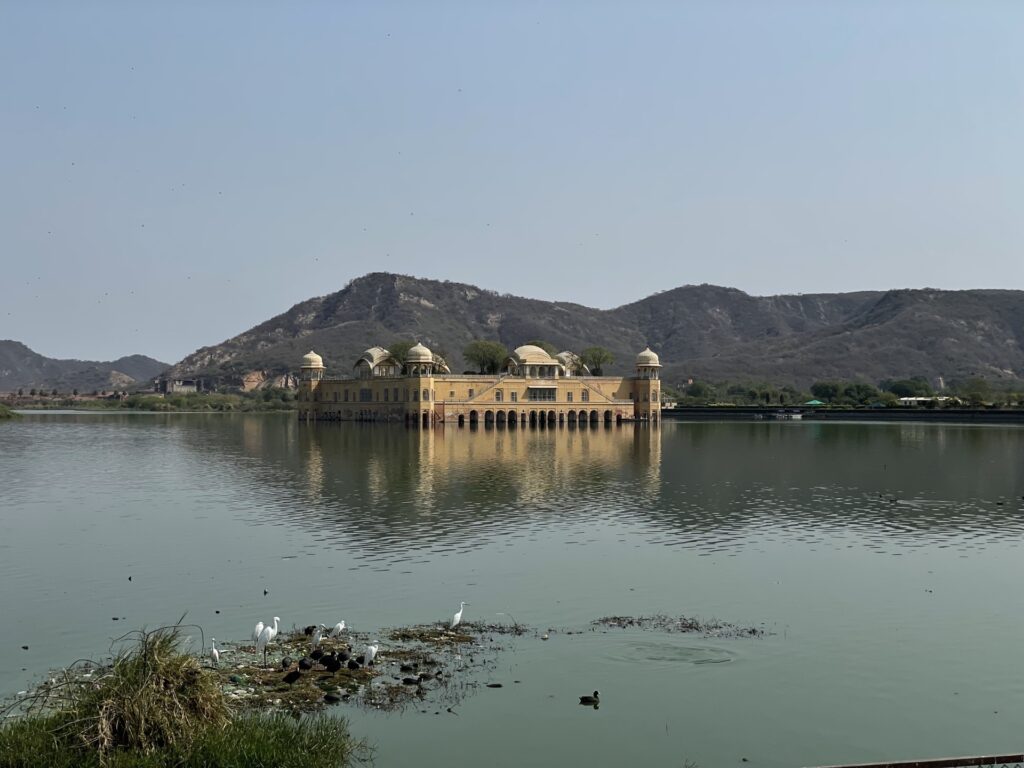
Today, you can only see the top floor of the lodge/palace above the water line. You can’t go inside, but you can see the palace from the shore.
When you hop out to see the palace, you’ll have to cross through a small street market. We saw booths selling everything from shoes and sunglass to toys and tattoos. (Real tattoos!) There was also little vehicles for kids to ride on (for a fee of course) and lots of food vendors. It’s fun for a stroll if you have time, but not a must-do.
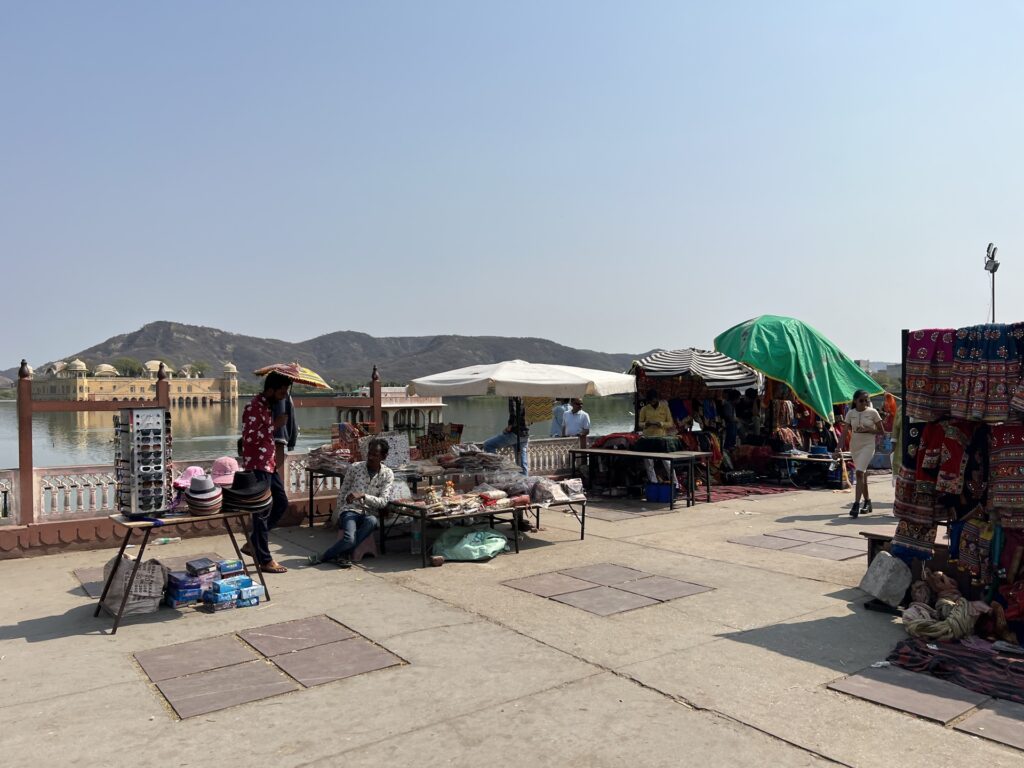
Hawa Mahal
- Location: Here — facing Hawa Mahal Road
- How to get there: If you’re coming from Jal Mahal, take a car or tuk tuk. You can also walk here from just about anywhere in the old city
- Hours: 9 AM – 4:30 PM, everyday (exterior is visible at anytime)
- Price: Rs. 200 to enter (exterior is free to view)
- Tickets: You can buy tickets online in advance here or there is a ticket window near the entrance.
- Guide info: Signs are posted in both English and Hindi.
- How long does it take: 1 hour
Amer Fort is the most popular attraction in Jaipur, but Hawa Mahal is the symbol of the city. The stunning exterior is made of pink and red sandstone, which plays into the city’s nickname of the Pink City. It was built for royal ladies to watch events and parades on the streets below.
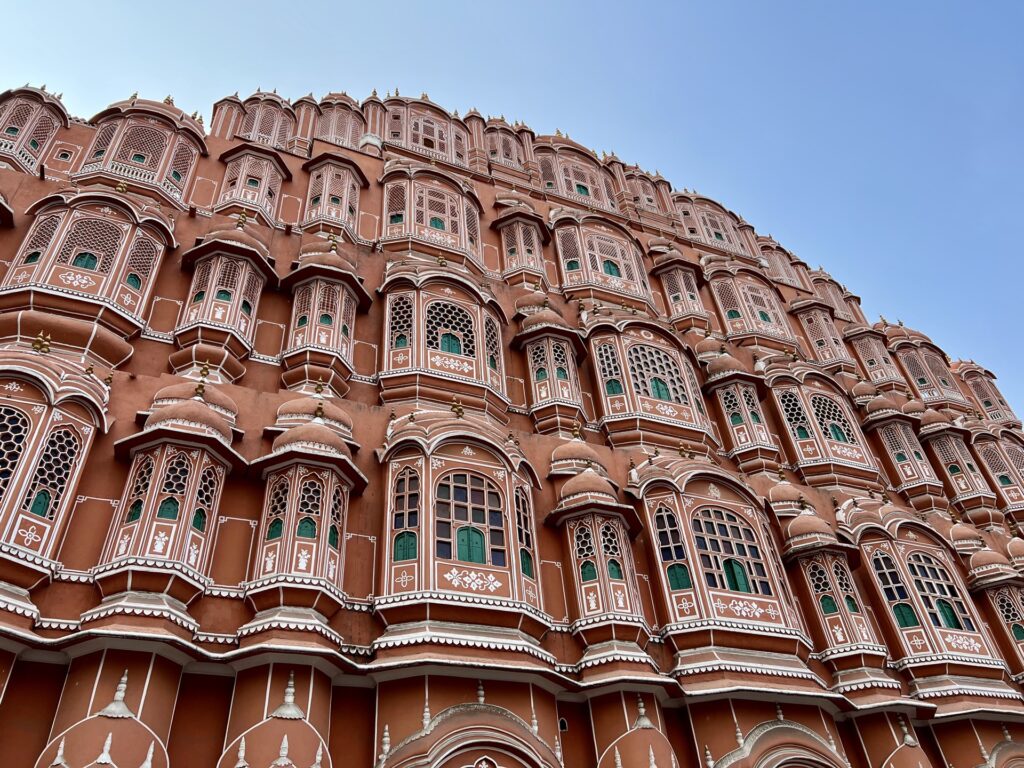
The most impressive thing about Hawa Mahal is its facade. You can see the building up close along Hawa Mahal Road or you can head to Wind View Cafe on the third floor across the street for a view from above.
Most people only see Hawa Mahal from the outside, but there is a small museum inside. You can learn about the history and walk through the building to see what the royal ladies once saw.
Jantar Mantar*
*If you have two days in Jaipur, head to Jantar Mantar next. However, if you only have one day, you might want to skip this one and do the City Palace or Bapu Bazar instead.
- Location: Here — the main entrance is just south of the City Palace
- How to get there: You can walk to Jantar Mantar from Hawa Mahal or the City Palace. If you’re coming from somewhere else, a car or tuk tuk can drop you off near the entrance.
- Hours: 9 AM – 4:30 PM, everyday
- Price: Rs. 200
- Tickets: You can buy tickets online in advance here or there is a ticket window near the entrance. (Tip: At the ticket booth, there is a separate queue for foreigners which is usually shorter.)
- Guide info: Guides are available for hire for Rs 200 – 500 depending on your group size.
- How long does it take: 1 hour
Jantar Mantar is an observatory with several historical astronomical instruments. Built in the early 1700s, the large, stone structures take different measurements, tell time, track stars, etc.
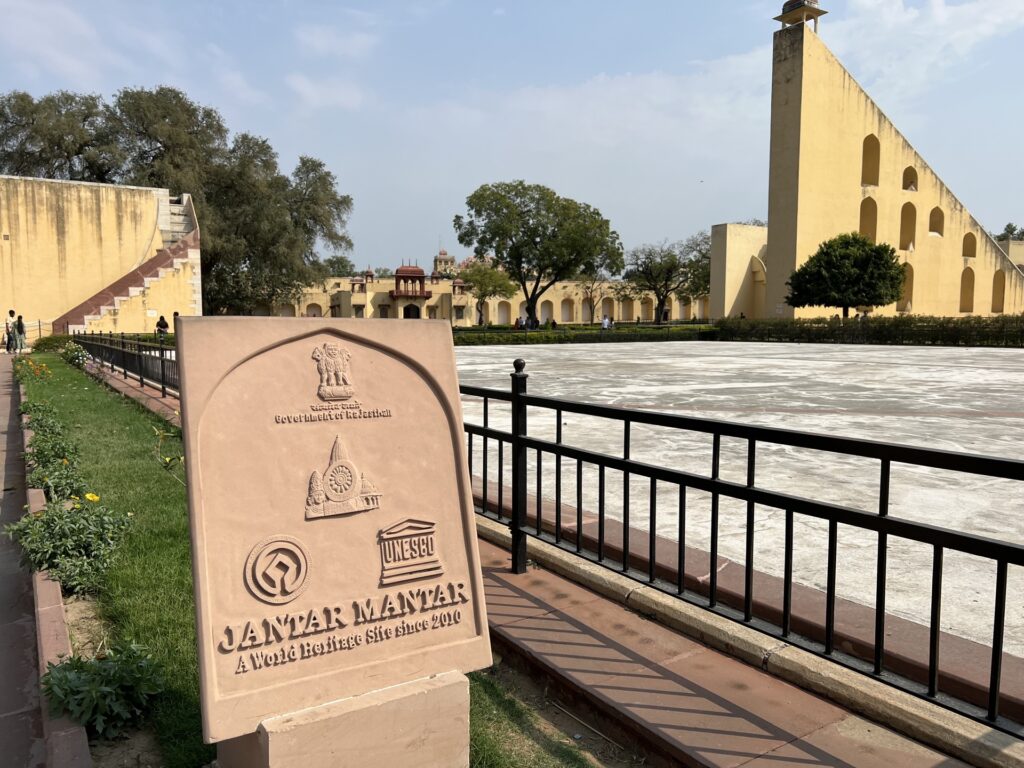
There are a few signs throughout the observatory in both Hindi and English that explain what the devices were used for. If you really want to understand, though, you should probably hire a guide. If not, think of it as more of an outdoor art gallery. The large, geometric structures are impressive and beautiful even if you don’t know what they do.
It gets pretty hot at Juntar Mantar in the afternoon, and there isn’t much shade. There is a cafe that sells cold bottled beverages and some snacks that has shaded seating.
After Juntar Mantar, it will probably be close to dinner time. If you have another day in Jaipur, we’d suggest heading back to your hotel for dinner and drinks before going into another busy day. If this is your only day, you might want to squeeze in more of the activities from day 2 below.
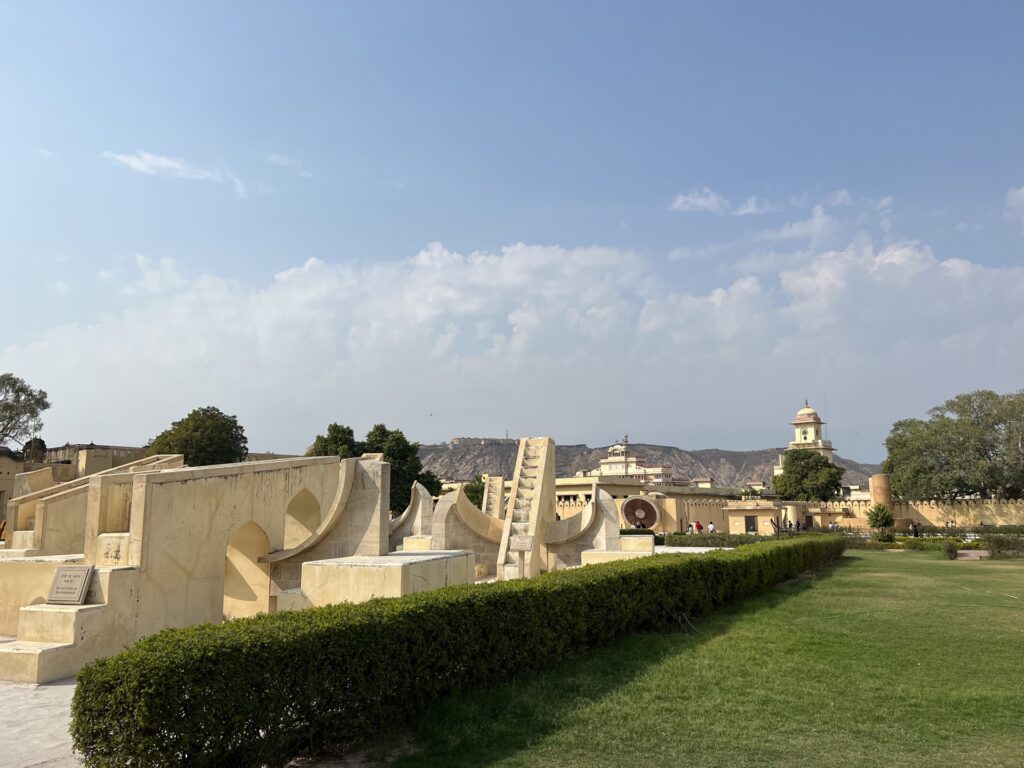
Day 2 — Old City & Bazar
On our second day in Jaipur, we’ll stay in Jaipur City. Once you get to the City Palace, you can walk around the bazar and old city on foot. If you want to visit the last place on this list, you’ll need a car or tuk tuk.
We suggest starting early and getting to the City Palace when they open around 9:30 AM to beat the heat and the crowds.
We personally only spent one full day exploring Jaipur. Our specific itinerary was everything listed above in day 1, plus Bapu Bazar. We had this second day planned, but didn’t end up getting to do it because we all just needed a break. Even though we didn’t do all of these things, we wanted to include them so you could pack them in if you want.
Jaipur City Palace
- Location: Here — in the middle of the old city
- How to get there: Depending on where you’re coming from you can take a car/tuk tuk, walk, or even take the Metro to Badi Chaupar station.
- Hours: 9:30 AM – 7 PM, everyday (museum is only open 10 AM – 6 PM and the ticket window closes at 5 PM)
- Price: Rs. 300 for basic entry. A royal tour through all the rooms is more expensive. There is no official price and it can vary.
- Tickets: It’s best to buy tickets at the ticket booth near the entrance. You can also buy tickets online here, but only the more expensive composite ticket.
- Guide info: Guides are available for hire at the site for Rs. 400 – 600, depending on your group size. Audio guides are also available and signs are posted in English and Hindi.
- How long does it take: 1 hour
Jaipur City Palace was built in the 1700s when the capital was moved to Jaipur. The Jaipur royal family still resides in the palace today, so much of the palace is closed off to the public.
Visitors to the City Palace can enter some of the courtyards, but the main tourist attraction is the Maharaja Sawai Man Singh II Museum. The museum explores Jaipur’s history through textiles, weaponry and art. You cannot enter many of the palace rooms without paying for a royal private tour, which is a few thousand rupees.

Since we didn’t personally explore this palace, I’ll defer you to Common Wanderer for a beautiful photo tour of the palace.
For what it’s worth, I’ve heard mixed reviews about the City Palace. Some people claim it’s wonderful and beautiful, but most seem to say it’s fine to skip.
Bapu Bazar
- Location: Here — Bapu Bazar street between Chaura Rasta Road and Sanganeri Gate
- How to get there: You can walk here from most anywhere in the old city. Otherwise have a car or tuk tuk drop you at either end of the market.
- Hours: 11 AM – 8 or 10 PM, everyday (some stores close earlier)
- How long does it take: 1 hour
We love a street market and this is a fun one. We didn’t get to spend much time walking around Delhi, so we went out of our way to explore more of Jaipur on foot. If you exit the City Palace area from Tripolia Gate, you can walk straight south to the bazar. This route isn’t overly touristy, so it’s fun to see the stores and restaurants that the locals go to.
Bapu Bazar is kind of really touristy, but also kind of not. If you walk through as a tourist, everyone will ask you to come into their shop. There are souvenirs like t shirts and magnets, but it’s mostly textiles. Most of the shops sell pashminas, shoes and traditional clothing. It felt like most of the people actually shopping at the bazar were locals and/or Indian tourists.
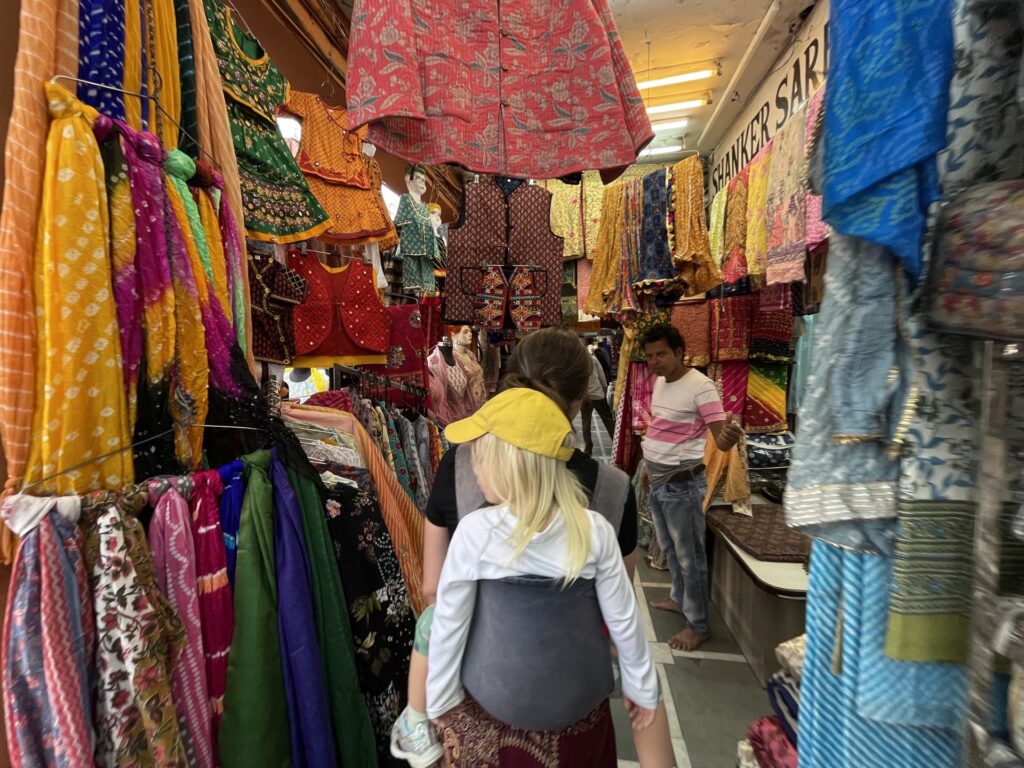
The bazar was really beautiful to walk through. If you stop to shop it can take about an hour. Otherwise, you can move through it pretty quickly. If you’re walking west to east, you’ll end at Johari Bazar Road, which is another shopping street. Walking back north to City Palace is another fun route, or you can walk south to Albert Hall.
Albert Hall
- Location: Here — south of Jaipur old city
- How to get there: You can walk from the old city or take a short tuk tuk ride
- Hours: 9 AM – 5 PM, everyday
- Price: Rs. 150
- Tickets: You can buy tickets online in advance here or there is a ticket window near the entrance
- Guide info: Signs are posted in both English and Hindi.
- How long does it take: 1 hour
Albert Hall is an art museum in Jaipur. It’s the oldest museum in Jaipur and was first opened in 1887. The museum highlights a collection of Indian works ranging from pantings and sculptures to carpets and weapons.
While the museum itself is well regarded, many people say the exterior alone is worth a visit. The building is beautiful from the outside, day or night. It’s free to enter the courtyard to see the exterior.
We personally got a little turned around after Bapu Bazar and unfortunately missed Albert Hall. I would have really liked to see this one!
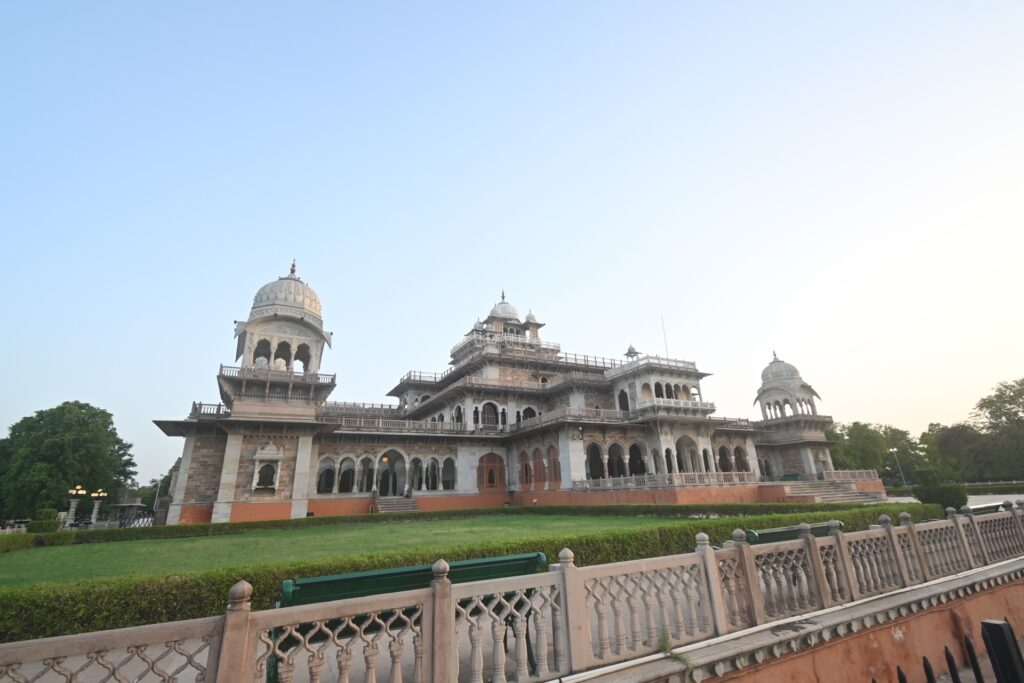
Patrika Gate
- Location: Here — far south side of Jaipur
- How to get there: You will need to take a car or tuk tuk here
- Hours: Open all the time
- Price: NA
- Tickets: NA
- Guide info: NA
- How long does it take: 30 minutes, but it takes a while to get there
This gate is pretty new, and was only built in 2016. It sits in the center of a traffic circle, far away from almost every other tourist attraction in Jaipur. But if you are willing to make the trip down to Patrika Gate, beauty awaits.
Patrika Gate was basically built for Instagram. From the outside, it mirrors the architecture and pink color synonymous with Jaipur. On the inside, a series of symmetrical archways are painted with a rainbow of colors that create the most stunning frames.

It’s a popular spot for photo shoots, whether you’re a newlywed or an influencer. In fact, photos are pretty much the only thing to do there. But if that’s your thing, it’s totally worth it.
And that actually wraps up our second day in Jaipur! Depending on what you went inside and what you just walked past, this schedule might take you to lunch time or well past dinner time. If you need more to do, though, keep reading!
More things to do in Jaipur
In the above itinerary, we’ve covered the best and most popular things to do in Jaipur. However, if you’re looking to try something different or if you have more time to fill, here’s a few more ideas.
- Nahargarh Fort: This fort is up in the hills past Amer Fort and Jaigarh Fort, so it’s best to do them all at the same time. This one is the highest of the three forts and has the best views.
- Gaitore Ki Chhatriyan: This is a crematorium for the royals with several stone and marble domed memorials. It’s very beautiful and not very crowded, so it’s a good place to explore outside of the standard tourist route.
- Isarlat: For more great views over Jaipur City, head to the top of this 7-story minaret. Jaipur was the first “planned city” with a grid system in India, and there’s no better way to see it than from the top of this pillar.
- Sisodia Rani ka Bagh: If you need to escape the noise of the city, head to this lovely garden. The fountains and painted gates make for a great photo op, too.
- Birla Mandir Jaipur: This Hindu temple was built in the late 1980s. It’s famous for it’s marble carvings and sculptures as well as its stained glass windows.
Closing thoughts on Jaipur
We liked Jaipur but didn’t love it. The highlight of our visit was definitely watching the chaotic traffic zip by in the old city. The Amer Fort was also great and we did really enjoy Bapu Bazar.
I think Jaipur was just built up a lot for us. We had low expectations for Delhi and high expectations for Jaipur, and our experience in both were flipped. We loved Delhi more than we thought and Jaipur less than we thought.
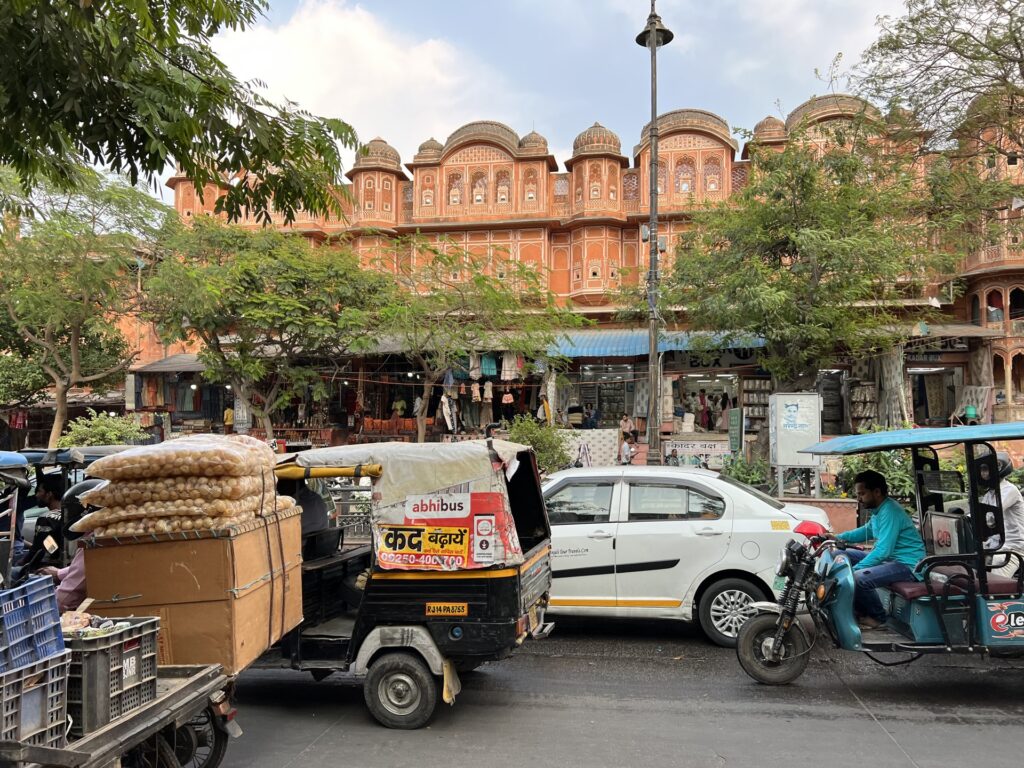
What’s tough is that I think you actually only need one full day in Jaipur, but that ends up taking three because you need a day to get there and another day to get to your next city. That is a lot of time if you’re also visiting Delhi and Agra, or any other cities.
If you have time for a full Golden Triangle trip (at least 8-10 days), of course you should visit Jaipur. But if you were short on time, I would honestly say it’s not worth the three days it takes to get here.
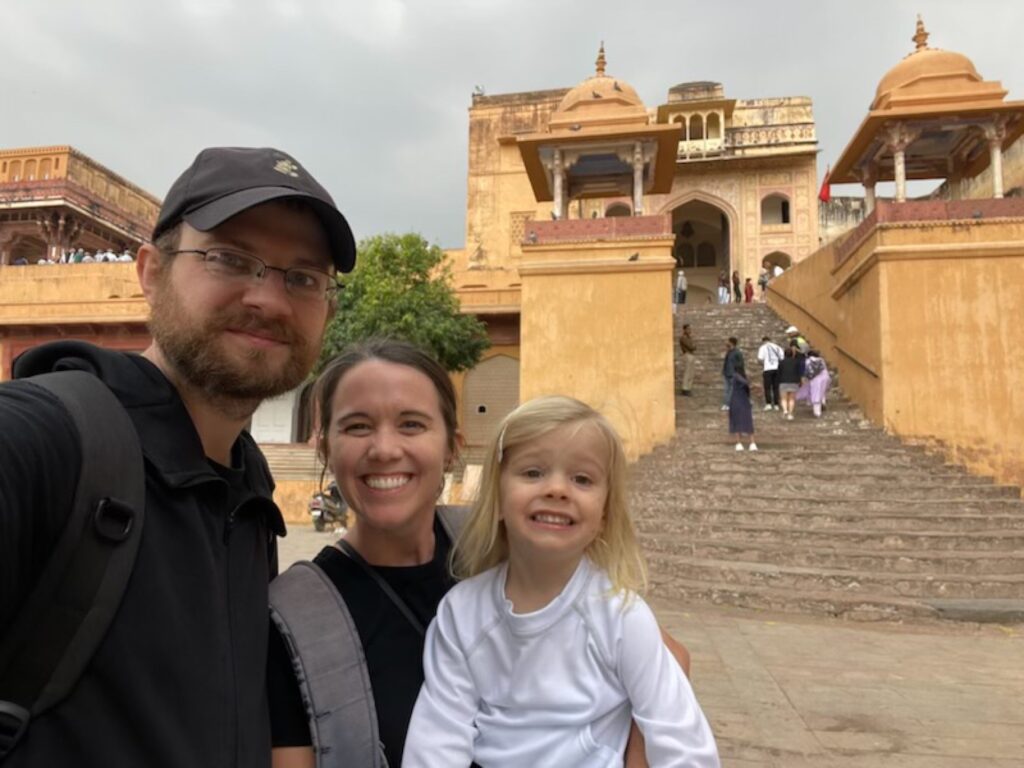
More From This Trip
- Emirates Business Class Review – A380 JFK to DXB
- Our Stay at Atlantis Dubai – A Perfect Place to Recharge
- Detailed 2-Day Dubai Itinerary
- Air India Business Class Review – 787 from DXB to DEL
- A Parent’s Guide to Traveling to India with Kids
- India Golden Triangle in 10 Days [Travel Guide, Itinerary &Tips]
- 3 Days in Delhi – Sample Itinerary + Planning Guide
- The Oberoi New Delhi Hotel Review
- Jaipur Itinerary – 1 or 2 Days in the Pink City
- Review of Jai Mahal Palace (Jaipur)
- Train from Jaipur to Udaipur – AC 3-Tier Sleeper Class
- The Oberoi Udaivilas Hotel Review (Udaipur)
- Udaipur Travel Guide + Things To Do
- Celebrating Holi in Udaipur (With a Kid)
- Overnight Train from Udaipur to Agra – AC First Class Sleeper
- The Oberoi Amarvilas Review: A Luxury Hotel with Taj Mahal Views
- Kerala Express Review – Agra to Delhi in AC 2-Tier Sleeper Class
- Hotel Review: JW Marriott New Delhi Aerocity
- Qatar Airways Economy Review – DEL to DOH
- Doha Things To Do & Travel Guide (Perfect for a Stopover!)
- Qatar Airways Qsuite Review – 777 from DOH to JFK
